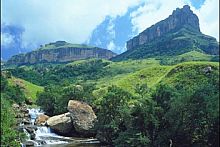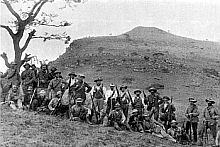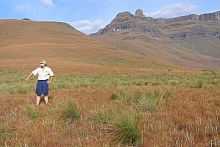SAEON spearheads research programme on Maloti-Drakensberg World Heritage site
|
- Prof Tim O’ Connor, Observation Science Specialist, SAEON
SAEON has initiated an observation and research programme in the Maloti-Drakensberg region in conjunction (at this stage) with Ezemvelo KZN Wildlife, the University of the Witwatersrand, and the University of KwaZulu-Natal.
The seed programme described in this communication should provide a platform for other interested parties to join in and contribute to understanding long-term patterns of ecosystem change of this magnificent mountain landscape, which is a premier tourist destination and whose foothills support a large rural community.
But it is not only the Drakenberg’s mountain splendour which has attracted attention – this landscape offers an ideal field laboratory for observation and study of global change. Improving our understanding of global change is one of the five Grand Challenges of the Department of Science and Technology, and the core mandate of SAEON.
But what is global change?
The media emphasize the importance of climate change, but there are many other human impacts affecting the capacity of our ecosystems to deliver the services on which society depends.
Increasing atmospheric concentrations of CO2 not only affect climate but may have a direct fertilisation effect on C3 as opposed to C4 plants, the first being characteristic of woody plants and temperate grasses and the latter being characteristic of sub-tropical grasses. This effect has been implicated in an increase of woody plants in savanna and grassland across the globe.
Might we witness the ingress of savanna or expansion of forest into the Drakensberg grasslands?
Dynamics of woody plants and the existence of grassland depend on fire, but fire pattern and behaviour may change over time in response to changing climate and vegetation. The vulnerability of different vegetation types and their response to fire might also change; for example, anecdotal evidence suggests that forests are becoming more flammable.
The Drakensberg is even affected by the pollution plume and resultant acid deposition emanating from Gauteng. But the most obvious impact is that of human settlement and activity. Large- or small-scale crop production, livestock ranching, dairy farming, and plantation forestry are but a few of the land uses evident in the Drakensberg that all have different impacts on this ecosystem.
We are thus faced with a multitude of factors affecting change simultaneously. The aim is not simply to show that change is occurring, but to understand the effect of different drivers of change on ecosystem structure and functioning.
A second challenge is the scale at which we seek answers. There are few examples of examining an ecosystem-level response to global or climate change. There are good reasons why not. Ecosystems are complex. Predicting their response under ‘natural’ conditions is challenging enough without the added complexity of global change impacts.
There is, however, a pressing need to aggregate understanding of responses of components or processes into an understanding of ecosystem-level response. Failure to include the complexity of ecosystem structure and functioning increases the risk of erroneous prediction of global change impacts.
Against this backdrop, there are a number of ecological and human reasons why the Drakensberg is so valuable for achieving this aim. The main anthropogenic impacts on the region are climate change, carbon loading and land use. This reduced subset renders it easier to separate effects of each.
Long history of research and monitoring
The main land uses are neatly juxtaposed alongside one another allowing direct comparison. The area has enjoyed a long history of research and monitoring covering the main ecosystem components. There are some excellent data bases available that allow us to examine the amount of change that has occurred over the past few decades rather than only measuring baselines for detecting change some time into the future.
The protected area is a relatively simple system driven mainly by fire and climate with the added advantage that human impacts are minimised. Its relatively stable climate allows directional changes resulting from climate change to be more easily discerned from natural climatic variability. Another advantage of montane environments is that climate-induced changes are also more readily evident over sharp altitudinal gradients than across flat plains.
A first question is whether there is any evidence of directional change in climate. We know atmospheric CO2 continues to increase. What are the consequences of these changes for ecosystem structure and functioning?
A start is made with study of long-term patterns in the fire regime at a landscape scale as fire is a main ecosystem driver. A robust foundation exists for understanding vegetation changes. Fire has been precluded for up to sixty years at Cathedral Peak, Giants Castle, and nThabamhlope, thereby offering an unparalleled opportunity to examine succession from grassland to woodland/forest.
Aerial photographs are another invaluable source of evidence of the ingress of woody elements into grassland. They offer a 70 -year history that can be extended to 110 years using photographs from the Boer War – the wooded thickets on the flanks of Spioenkop were absent then. Study of bush encroachment on outlying hills in relation to management and topographic influences on fire may presage what lies ahead for the Berg.
Herbaceous vegetation has also received close attention in the past. Additional long-term fire and grazing experiments, plus numerous fence-line contrasts between the protected area and areas accessed by livestock, will allow a comprehensive assessment of forces of change of this vegetation component. Altitudinal transects will be consolidated from existing plots of herbaceous vegetation in order to examine altitudinal shifts in vegetation, especially the expected expansion of C3 grasses and other plants at lower altitude.
Impact on wild animal populations
Changes in fire regime and vegetation would affect the quality and quantity of resources on which large mammalian herbivores subsist. There is concern about oribi, klipspringer may already have been lost, red hartebeest have been unsuccessfully reintroduced, eland and bushbuck thrive, while the well-being of grey rhebuck and mountain reedbuck is unknown.
Have predators increased? Are they affecting herbivore populations? These questions can be successfully addressed based on long-term monitoring and following up previous studies.
The above-described efforts are simply the first steps in addressing a complex system that capitalise on past research and monitoring. In the near future it is hoped that greater attention can be paid to the influence of land use on ecosystem services.
The pioneering efforts of Terry Everson of the University of KwaZulu-Natal and her collaborators in the rural areas of the foothills provide a platform for comparing rural settlement, protected area, commercial agriculture, and plantation forestry.
The Department of Water Affairs and Forestry have recognised a need for improved information on the effect of climate change on water resources that may lead to resuscitation of the 60-year old catchment experiments at Cathedral Peak.
Study continues on flagship species such as vultures, while a recent broad assessment of biodiversity might serve as a basis for examining security of biodiversity in this World Heritage Site and its surrounds.
Any interested parties can contact the programme coordinator Tim O’Connor at timoconnor@xsinet.co.za







